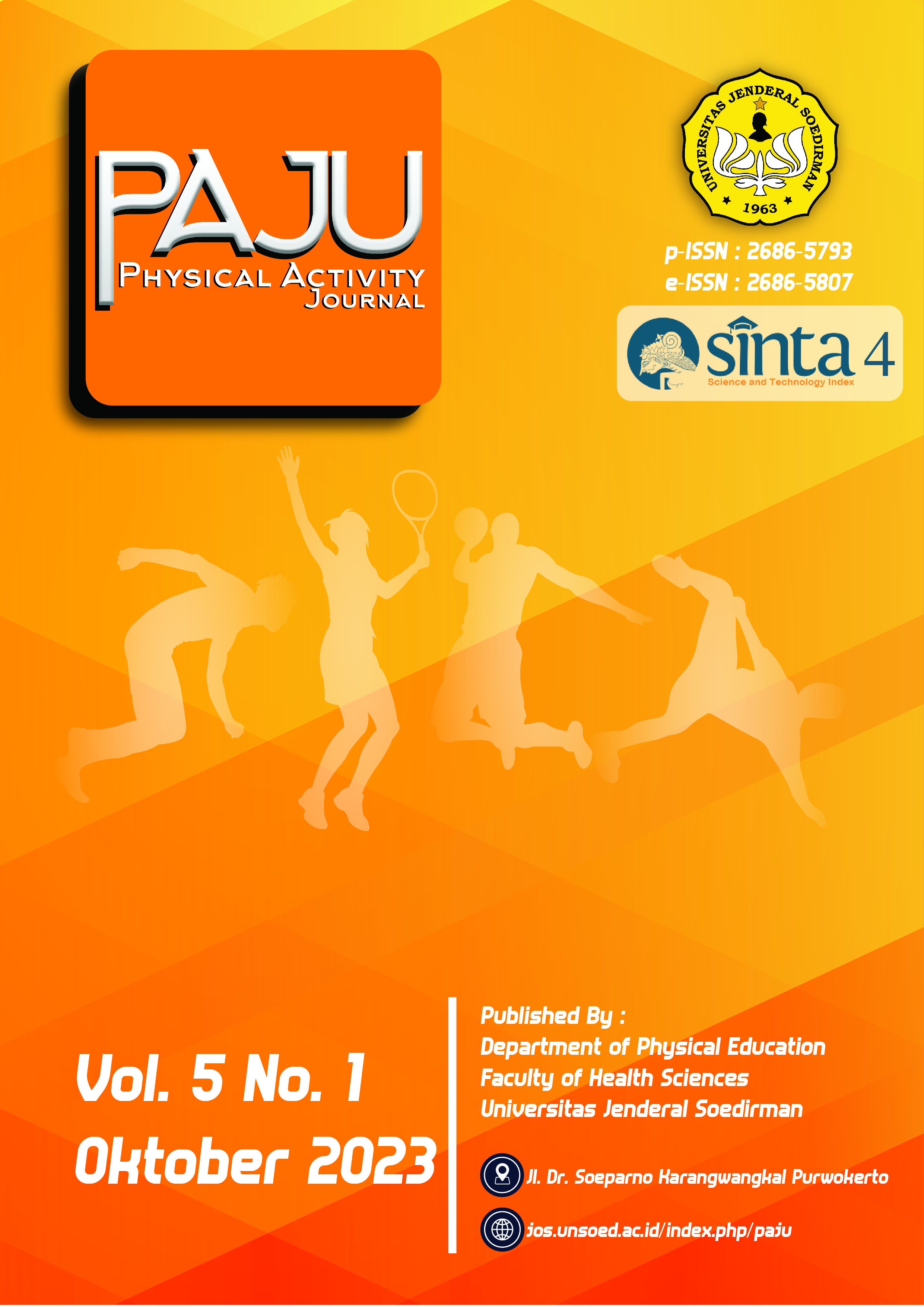Implementation of the Inquiry Model on the Critical Thinking Ability of Prospective Physical Education Teachers in Football Learning
Abstract
Physical education is not just about learning skills from several basic techniques in sports including football. Currently, football needs to be supported by critical thinking skills to produce a more focused and efficient game. The aim of this research is to implement an inquiry learning model on students critical thinking skills in the game of football in the aspects of maintaining possession of the ball, creating space in attack, and shooting the ball into the goal. The method used was an experiment with The Randomized Posttest Only Control Group Design. The total sample was 70 students divided into two groups, namely the experimental group of 35 people who were given inquiry model treatment and the control group of 35 people who were given conventional model treatment. The instrument for measuring critical thinking skills uses an observation sheet whose level of validity has been tested. The results of the research show that students critical thinking abilities for the inquiry model in football learning in the aspect of maintaining possession of the ball are in the very good category, while for the conventional model in this aspect they are in the good category. Students critical thinking skills for the inquiry model for the aspect of creating space in attack are in the very good category, while for the conventional model in this aspect they are in the good category. Students critical thinking skills for the inquiry model in the aspect of shooting the ball into the goal are in the very good category, while for the conventional model in this aspect they are in the good category. The application of the inquiry model for students as prospective physical education teachers in order to improve critical thinking skills in football game material has a significant impact.
References
Bjonness, B., & Kolsto, S. D. (2015). Scaffolding open inquiry: How a teacher provides students with structure and space. Nordic Studies in Science Education, 113, 223–237. https://doi.org/https://doi.org/ 10.5617/nordina.878
Cairns, D., & Areepattamannil, S. (2019). Exploring the relations of inquiry-based teaching to science achievement and dispositions in 54 countries. Research in Science Education, 49(1), 1–23. https://doi.org/https://doi.org/10.1007/s11165-017-9639-x
Crawford, B. A. (2014). From inquiry to scientific practices in the science classroom. (Handbook o & S. K. A. G., In N. Lederman, Ed.). Routledge
Estrella, G., Au, J., Jaeggi, S. M., & Collins, P. (2018). Is inquiry science instruction effective for English language learners? A meta-analytic review. AERA Open, 4(2). https://doi.org/https://doi.org/10.1177/2332858418767402
Furtak, E. M., Seidel, T., Iverson, H., & Briggs, D. C. (2012). Experimental and quasi-experimental studies of inquiry-based science teaching. Review of Educational Research, 82(3), 300–329. https://doi.org/https://doi.org/10.3102/0034654312457206
Harlen, W. (2011). Why is Learning Science Important in Primary Schools. Chapter 1. In ASE Guide to Primary Science Education (New Edition), edited by W. Harlen, 2–9. Hertfordshire: Association for Science Education (ASE)
Harlen, W. (2014). Helping Childrens Development of Inquiry Skills. Inquiry in Primary Science Education (IPSE)
Jack R. Frankel., Norman E. Wellen., H. H. Y. (2012). How to Design and Evaluate Research in Education. In M. Ryan (Ed.), How to Design and Evaluate Research in Education (8th-ed ed., pp. 1–642). New York: McGraw-Hill
Karisman, V. A., Santosa, A., Budiman, A., Supriadi, D., Solihin, A. O., Friskawati, G. F., Kurnia, D. (2021). Sosialisasi Permainan Sepakbola Modern untuk Menambah Pemahaman Bermain Sepakbola Masyarakat Jampang Kulon. Jurnal Aksara Raga, 3, 70–74
Kersting, M., Karlsen, S., Odegaard, M., Olufsen, M., Kjaernsli, M., & Suhr Lunde, M. L. (2023). Studying the quality of inquiry-based teaching in science classrooms. A systematic video study of inquiry-based science teaching in primary and lower-secondary schools. International Journal of Science Education, (May), 1–22. https://doi.org/10.1080/09500693.2023.2213386
Lin, Z. (2016). Context-model-based instruction in teaching EFL writing: A narrative inquiry. Cogent Education, 3(1), 1–10. https://doi.org/10.1080/2331186X.2016.1154258
McCullagh, J., & Doherty, A. (2021). A coteaching model for developing pre-service teachers practice and confidence in teaching primary science through inquiry. Education 3-13, 49(3), 357–370. https://doi.org/10.1080/03004279.2020.1854963
Mesnan, M., Supriadi, A., & Siregar, I. (2019). Pengembangan Log Book Pembelajaran Sepak Bola Dengan Pendekatan Taktis. Jurnal Prestasi, 3(6), 68. https://doi.org/10.24114/jp.v3i6.15895
Metzler. (2000). Instructional Models For Physical Education. United States: Ally & Bacon
Muphy, C., L. Bianchi, J. F. McCullagh, and K. K. (2013). Scaling up Higher Order Thinking Skills and Personal Capabilities in Primary Science: Theory-Into-Policy-Into-Practice. Thinking Skills and Creativity, 10, 173–188. https://doi.org/10. 1016/j.tsc.2013.06.005
National Research Council. (2012). A Framework for K-12 Science Education: Practices, Crosscutting Concepts, and Core Ideas. Washington, DC: National Academies Press
Osborne, J. and Dillon, J. (2008). Science Education in Europe: Critical Reflections. 13. London: The Nuffield Foundation
Qvortrup, L. (2008). The First Global Education Forum. Teacher Education Quarterly, 1(2)
Riduan. (2010). Belajar Mudah Penelitian untuk Guru, Karyawan dan Peneliti Pemula. Bandung: CV Alfabeta
Risma, R., Nur, F., Siahaan, P., & Samsudin, A. (2015). Deskripsi Instrumen Tes Keterampilan Berpikir Kritis Materi Alat Optik. Simposium Nasional Dan Pembelajaran Sains 2015 (SNIPS 2015), 497–500
Setia, B. I., & Darmawan, G. (2018). Penerapan Pendekatan Taktis Untuk Meningkatkan Keterampilan Shooting Dalam Sepak Bola. Pendidikan Jasmani, Kesehatan Dan Rekreasi, Fakultas Ilmu Keolahragaan, Universitas Negeri Surabaya, 1–4
Sucipto, Bambang Sutiyono, Indra M. Tohir, & N. (2000). Sepakbola. Jakarta: Depdiknas
Tarigan, B. (2001). Pendekatan Keterampilan Taktis dalam Pembelajaran Sepakbola. Jakarta: Depdiknas
Teig, N., Scherer, R., & Nilsen, T. (2018). More is not always better: The curvilinear relationship between inquiry-based teaching and student achievement in science. Learning and Instruction, 56, 20–29. https://doi.org/https://doi.org/10.1016/j.learninstruc.2018.02.006
Teig, N. (2021). Inquiry in science education. Springer Open
Wilson, S. M. (2013). Professional Development for Science Teachers : Science 340 (6130), 310–313. https://doi.org/10.1126/science. 1230725

This work is licensed under a Creative Commons Attribution 4.0 International License.


















